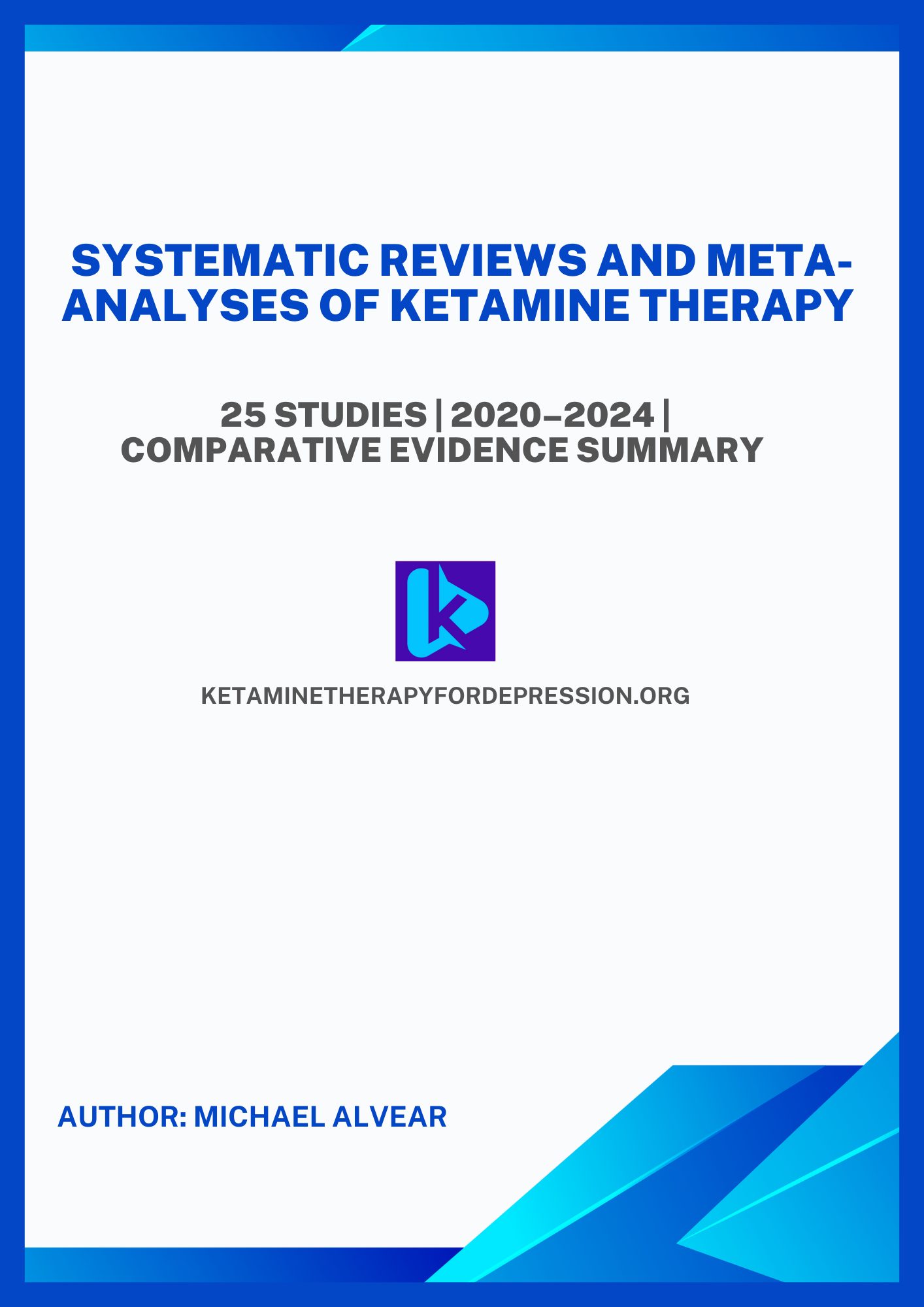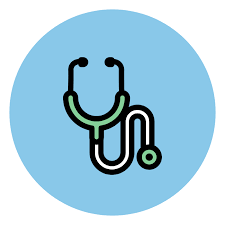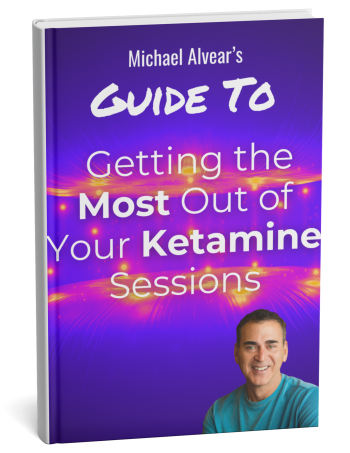Ketamine Therapy Side Effects: IV, Spravato & Oral/Sublingual
By Michael Alvear, Health Author & Independent Researcher
My research is published on these scholarly platforms:
Last Updated:
✓
Side Effects Experienced by Almost All Patients
- Pre-session: Brief dizziness or drowsiness
- During session: Temporary elevation in blood pressure and heart rate
- Post-session: Grogginess, mental fog, mild imbalance, and fatigue—typically resolving within 6-12 hours
◐
Less Common Effects (Small Minority of Patients)
- Headache
- Nausea or vomiting (generally mild and transient when it occurs)
?
What About Dissociation?
Dissociation—the feeling of detachment from your body or surroundings—is often listed as a side effect. However, many experts now consider it a therapeutic mechanism of action rather than an unwanted effect, as it may contribute to ketamine’s antidepressant properties.
!
Serious Complications
Serious adverse effects such as bladder inflammation, psychosis, substance dependence, and kidney or liver damage are rare at therapeutic doses and predominantly associated with prolonged, high-dose recreational use—not medically supervised treatment protocols.
Ready for a deeper dive? We’ve organized everything you need to know into 8 comprehensive sections.
↓
Click any card to jump directly to that section
Ketamine Therapy Side Effects: Route Comparison
Comparing Key Side Effects Across the Four Main Ketamine Routes: IV Infusion, Injection, Spravato Nasal Spray, and Oral/Sublingual.
Citations
The Primary Side Effects of Ketamine Therapy
Frequently Asked Questions
5 essential questions answered about timing, duration, and what to expect
What are ketamine’s side effects—and when do they actually happen?
Upon ketamine entering the system most people experience slight dizziness and drowsiness. Once ketamine crosses into the brain and the “journey” begins, most ordinary sensory input fades because you enter an alternate state of consciousness. Even the minority of patients who do experience side effects during this stage stop feeling them. Dissociation interrupts the brain’s ability to process external signals like discomfort, nausea, or pain—not by removing the cause, but by changing what the mind can perceive.
About half-way through the journey blood pressure tends to spike but rarely high enough to be of concern. After the journey ends—when awareness returns—almost all patients experience a mild to moderate grogginess, imbalance, mental fog, and fatigue lasting, depending on the individual, 6-12 hours, slowly attenuating over time. Some may experience short-lived, mild headaches. Others get nausea or vomiting, but this can be prevented by taking anti-nausea medication before the session or refraining from drinking or eating in the hours leading up to it.
These effects are most pronounced during the comedown phase, as the drug’s effects begin to wear off and your brain shifts back into normal consciousness. For many, it feels like waking up from a long nap in a dim room—slow, heavy, a little unsteady, but not unpleasant. The fog usually fades by evening.
Route of administration matters. IV ketamine kicks in quickly, leaving less time for early side effects to surface. Oral and nasal methods absorb more slowly, which may increase the chance of pre-journey symptoms.
Do the side effects of ketamine therapy go away quickly—or do they linger?
Almost all the side effects– grogginess, imbalance, fatigue, nausea or brain fog–fade away over the course of 6-12 hours (for some it’s shorter than that). Think of it like sliding down a long, gentle ramp—not crashing, just slowly returning to baseline.
Unlike SSRIs, which can produce daily side effects that accumulate over weeks, ketamine’s side effects are temporary and usually resolve within half a day. There’s no long adjustment period, and no waiting weeks to find out how your body will respond. What you feel, you feel that day—and then it’s over.
Are there any serious side effects I should know about—or do those mostly come from recreational use?
Yes, serious but rare side effects exist—but almost all come from much higher, more frequent doses than you’d ever get in depression treatment. In clinical settings, the risk profile is extremely low and well understood.
A few examples include cystitis (bladder inflammation), kidney damage, psychotic symptoms, addiction or dependence but again, this is seen almost exclusively in people who use ketamine heavily as a party drug. At therapeutic doses, it’s extremely rare—and usually resolves if treatment is paused. Another rare side effect is a temporary rise in liver enzymes, which doesn’t usually cause symptoms and is often only spotted in routine labs.
The most serious side effects almost always involve misuse. The kind of misuse that happens outside of a clinic, not inside one. If you’re working with a licensed provider who screens for risks and adjusts the dose carefully, you’re not in that category.
Is dissociation a side effect of ketamine therapy—or is it part of how the treatment works?
Dissociation isn’t a side effect. It’s the mechanism of action.
Medical websites often call it a side effect because they rely on outdated pharmaceutical templates—where anything strange or unfamiliar gets lumped in with symptoms like nausea or dizziness.
But dissociation isn’t a secondary physiological response. It’s the brain’s direct response to ketamine entering key neural pathways. What you feel as dissociation is what’s happening in your brain—disruptions to the default mode network, increased neuroplasticity, and temporary decoupling of sensory input and self-awareness. That’s not a side effect. That’s the drug doing exactly what it’s supposed to do.
It can be disorienting. For some it’s uncomfortable; for others a fascination. But it’s not a bug in the system. It’s the system working.
What are the long-term side effects of therapeutic ketamine?
When used in therapeutic settings with proper medical supervision, research shows no evidence of long-term cognitive damage, organ damage, or dependency. The risks you may have heard about are linked to high-dose recreational misuse—not the controlled, lower doses used in treatment. Therapeutic ketamine has a strong safety profile when administered by healthcare professionals.
Got Questions? Ask Me Directly.
Immediate Medical Risks During a Medically Supervised Ketamine Session
Rare but important complications that medical staff are trained to handle
These events are exceedingly rare in a properly screened patient at a therapeutic dose, but they are why licensed clinics have crash carts and trained staff.
Acute Hypertensive Crisis (Severe Blood Pressure Spike)
Ketamine naturally elevates heart rate and blood pressure, but in rare cases, this can spike too high, potentially risking a stroke or heart issue. If blood pressure remains elevated past the recovery window, the session may be aborted or the patient may be given medication to quickly reduce it.
Respiratory Depression or Laryngospasm
While ketamine is famous for being “respiratory sparing” (meaning it typically doesn’t stop breathing), combining it with other sedatives or a rapid dose can lead to slowed breathing. Laryngospasm (the vocal cords tightening) is a rare, sudden event that requires immediate clinical intervention to restore airflow.
Prolonged Psychotic Symptoms or Emergence Delirium
Most dissociation resolves within about 45 minutes. In extremely rare instances, patients may experience prolonged agitation, paranoia, severe confusion, or hallucinations (sometimes called “emergence delirium”) that last hours longer than expected. Clinicians monitor patients during the recovery window precisely to manage this rare, temporary state.
Takeaway:
These severe reactions are typically limited to anesthetic doses or misuse. If you are receiving a controlled, low-dose infusion or injection under medical supervision, your risk is minimal, but the fact that the clinic monitors your vitals proves they take this risk seriously.
Serious Side Effects of Ketamine Use
I’ll admit, I had reservations about writing this section. Rare side effects are tricky to talk about because no matter how many times you say “rare,” people tend to latch onto them and think, If they’re mentioning it, it’s probably going to happen to me.
I get it—listing side effects can be scary. It’s like those drug commercials on TV where half the ad is a rapid-fire list of terrifying things that could happen, leaving you wondering why anyone would risk taking it. The truth is, those lists are there because the law demands it, not because the risks are common. The same goes for ketamine therapy.
Rare side effects are exceedingly uncommon, and in most cases, they happen when ketamine is misused—through illegal dosing or excessive use as a party drug. In a controlled clinical setting, with the low doses used to treat depression, these side effects are highly unlikely. But if you’re going to trust the process, it’s important to have all the facts. So, let’s talk about them.
When administered under medical supervision in therapeutic settings, ketamine demonstrates an exceptionally favorable safety profile, with medically serious adverse events occurring in approximately 0.1% of patients. Research has found no evidence of long-term cognitive impairment, organ damage, or addiction development with supervised, low-dose ketamine therapy protocols.
Serious complications—including urological damage (bladder and kidney dysfunction), cognitive deficits, substance dependence, psychiatric complications (psychosis, depression), respiratory depression, cardiovascular events, and overdose—occur almost exclusively with prolonged, high-dose recreational use or unmonitored, unsupervised at-home administration. The severity of these adverse effects correlates directly with dosage and frequency of use, conditions absent in properly monitored therapeutic protocols.
Clinical ketamine therapy utilizes substantially lower doses administered by experienced medical personnel with continuous monitoring, distinguishing it fundamentally from recreational misuse patterns that precipitate serious complications.
Organ Damage and Urinary Issues
Chronic ketamine use can cause severe bladder inflammation, ulceration, and scarring, known as ketamine-associated cystitis—leading to frequent, urgent, and painful urination, incontinence, hematuria (blood in urine), and potentially irreversible bladder dysfunction[2][3][5][6][9]. Damage may also extend to kidneys and the urinary tract[6][9].
Mental and Cognitive Effects
Long-term effects include memory impairment, reduced attention, and persistent cognitive issues. Chronic use is linked to mood disorders, including depression, anxiety, and psychosis. Users may experience vivid hallucinations, flashbacks, and dissociative states even days or weeks after use[3][7][9][11].
Addiction and Dependence
Ketamine poses a risk for psychological dependence and addiction. Individuals may develop cravings and experience difficulty stopping use, with withdrawal symptoms primarily affecting mood and cognition[3][6][8][10].
Cardiovascular and Respiratory Complications
Serious complications can include increased heart rate, high blood pressure, seizures, and respiratory depression (slowed or stopped breathing). Overdose may result in unconsciousness, coma, or death, especially when combined with other depressant substances[3][4][5][6][7][9].
Liver Damage
Ketamine can cause abnormal liver function and, in rare cases from prolonged use, liver injury evidenced by jaundice, abdominal pain, and other symptoms indicative of hepatic stress[2][4][9].
Summary Table
Patients with chronic ketamine use should seek medical attention for these symptoms, as many complications may be irreversible or life-threatening without proper intervention[3][5][6].
Is Ketamine FDA-Approved for Depression?
Why Aren’t Ketamine Lozenges, Troches, and Rapid Dissolving Tablets FDA-Approved?
Ketamine lozenges, troches, and RDTs (Rapidly Dissolving Tablets) made by compounding pharmacies are not FDA-approved drug products for any purpose, including psychiatric or pain-related conditions. We understand this raises an immediate question: If ketamine is used medically for depression and other conditions, how can these formulations not be FDA-approved? This seems contradictory, but there’s an important regulatory distinction that clarifies everything.
Why This Makes Sense: The Difference Between a Drug and a Drug Product
The FDA approves specific drug products—meaning a particular medication in a particular form, dose, and delivery method that has undergone rigorous clinical testing. Ketamine itself is FDA-approved as an injectable anesthetic administered in medical settings, and esketamine (branded as Spravato) is FDA-approved as a nasal spray specifically for treatment-resistant depression. These specific products have been extensively studied and reviewed by the FDA.
However, when a compounding pharmacy creates ketamine in lozenge, troche, or RDT form, they’re making a different product that hasn’t gone through the FDA’s approval process. The active ingredient (ketamine) may be approved for other uses, but these particular formulations—designed for sublingual or oral absorption, often for at-home use—have never been evaluated by the FDA for safety, effectiveness, or quality control.
How Is This Legal?
This is where “off-label” prescribing comes in. Licensed physicians can legally prescribe compounded ketamine lozenges, troches, or RDTs when:
- No suitable FDA-approved alternative meets the patient’s specific medical needs
- The prescribing physician determines it’s medically appropriate for that individual patient
- The compounding pharmacy and clinician comply with DEA regulations and state pharmacy laws
As the FDA explicitly states: “Compounded drugs, including compounded ketamine products, are not FDA approved, which means FDA has not evaluated their safety, effectiveness, or quality prior to marketing.” However, these compounded formulations may be legally produced “for patient use based on an individual prescription” because the FDA does not regulate the practice of medicine itself—physicians retain the authority to prescribe what they determine is best for their patients.
The Bottom Line
Compounded ketamine lozenges, troches, and RDTs exist in a legal space where experienced clinicians can prescribe customized formulations when appropriate, even though these specific products haven’t received FDA approval. This is standard practice across many areas of medicine, particularly for patients who need alternatives to commercially available medications. When prescribed by qualified medical professionals through reputable compounding pharmacies, this represents legitimate medical care—not an unregulated gray area.
FDA Warnings About At-Home Ketamine Use
An estimated 16% of ketamine therapy is currently being administered at home with minimal or no medical supervision—a practice the FDA has repeatedly warned poses significant safety risks. While at-home ketamine treatment may seem convenient, the FDA has issued multiple public safety alerts specifically addressing the dangers of using compounded ketamine products outside of a monitored clinical setting.
What the FDA Says About At-Home Ketamine
The FDA has been clear and consistent in its warnings: compounded ketamine products used at home for psychiatric conditions present serious risks when a healthcare provider is not present to monitor the patient and respond to complications.
According to the FDA’s October 2023 warning: “Use of compounded ketamine products without monitoring by a health care provider for sedation (sleepiness), dissociation, and changes in vital signs (such as blood pressure and heart rate) may put patients at risk for serious adverse events.”
The agency further states: “Home use of compounded ketamine products presents additional risk because onsite monitoring by a health care provider is not available.”
Why This Matters
Ketamine can cause unpredictable effects including profound sedation, dissociation (feeling detached from reality), significant increases in blood pressure and heart rate, respiratory depression, and psychiatric events. When these occur at home without medical personnel present, there is no one trained to recognize warning signs, intervene appropriately, or provide emergency care if needed.
What About Having a “Sitter” Present?
Many telemedicine ketamine providers recommend having a friend or family member act as a “sitter” or observer during at-home sessions. While this is better than being completely alone, it’s important to understand that a lay observer is not a substitute for qualified medical supervision. A friend or family member cannot monitor vital signs, recognize medical emergencies with the same expertise, or provide clinical interventions that may be necessary.
The FDA’s warnings specifically reference the need for monitoring by a healthcare provider—someone with medical training who can assess and respond to complications in real-time.
The Bottom Line
The safest approach to ketamine therapy involves administration in a clinical setting with trained medical professionals present to monitor your response and manage any adverse effects. If you’re considering ketamine treatment, ask your provider about their monitoring protocols and whether treatment will occur under direct medical supervision. The FDA’s warnings exist to protect patients—and they reflect real risks that have been documented when ketamine is used without proper medical oversight.
My Experience With Ketamine Therapy Side Effects
From Queasy to Constipated
I definitely felt nauseous an hour or two after my first ketamine session. Luckily, my psychiatrist had given me a prescription for Zofran (ondansetron), but here’s the catch—it didn’t work all that well because I took it after I started feeling sick. Rookie mistake.
Once I learned to take it before the session, the nausea improved, but it didn’t disappear entirely. Eventually, I doubled the dose, and that did the trick—I never experienced nausea again. But then came the trade-off: Zofran put me squarely in the 9–11% of people who get constipated. So there I was, balancing it out with laxatives and, God help me, eating a lot of prunes.
I won’t lie—it was a hassle. But I seem to be in the minority here. Statistically and anecdotally, most people don’t need anti-nausea meds for ketamine therapy, and even if they do, they usually don’t deal with constipation. I’ve got a few friends who went through ketamine therapy, and none of them had the same issues I did.
When You Gotta Go You Gotta Go
During my first couple of ketamine sessions, I had such an urgent need to pee that it completely distracted me from the journey. I’d be mid-session, trying to stay present, and all I could think was, “I need to pee!”
The clinic mentioned that a few other people had experienced the same thing, but it wasn’t common. There’s not much you can do to eliminate it entirely, but I found a couple of tricks that helped: I stopped drinking water for a few hours before the session, and I always made sure to hit the bathroom right before the ketamine was administered.
These little adjustments made all the difference, letting me fully settle into the experience without distraction.
How Can You Be Sure Ketamine Therapy Actually Works?

I pulled together 33 systematic reviews from the last five years into one report—so you don’t have to rely on hype, guesses, or anecdotes. This is the highest level of real-world evidence we have.
Inside My Report You’ll Find
- What percent of patients enter remission—broken down by delivery method
- Which method is most effective—IV, injection, or Spravato nasal spray
- How fast ketamine can work to reduce or end symptoms
- Which combinations (like psychotherapy) may enhance response
- And a lot more…
Verified by the Platforms That Matter
This research summary report has been published across four trusted platforms that host peer-reviewed or open science content, including:
– Published ketamine research on Zenodo
– Ketamine evidence summary hosted on SSRN
– Scientific report on ketamine outcomes on Figshare
– Evidence-based ketamine therapy report on OSF





